An Inquiry into Bhutanese Agriculture Research–Practice Gaps Using Rogers Innovation Adoption Attributes and Mode 2 Knowledge Production Features
Abstract
1. Introduction
1.1. Innovation Adoption and Attributes
1.2. Knowledge Production
1.3. Mode 1 Knowledge Production
1.4. Mode 2 Knowledge Production
1.5. Mode 3 Knowledge Production
1.6. Problem Statement and Research Questions
- Identify the research and adoption factors that contributed to the research–practice gap in the Bhutanese agricultural context over the past two decades
- Identify the topical divides among public research institutes (PRIs) against the common vision of narrowing the research–practice gap.
- Identify the way forward for PRIs to enhance societal relevance and accountability and sustain agriculture research and innovation.
2. Methodology
2.1. Search/Identification and Screening
2.2. Inclusion Criteria
- Published in the Bhutanese journals
- Only peer-reviewed journal articles
- Publicly accessible journal articles through websites or webpages
- Research pertaining to crops and adjacent subjects
- Published in the English language
- Published between the years 2006 to 2020
2.3. Evaluation Criteria and Scoring System
2.4. Data Analysis
3. Results and Discussion
3.1. Principal Components and Variable Significance
3.1.1. Quality of Representation for the Variables/Factors
3.1.2. Contribution to the Variance by the Factor Variables
3.1.3. Topical Clusters Based on Factor Variables
3.2. Findings from the Assessment Using Rogers Innovation Attributes
3.3. Rogers Innovation Diffusion Elements and Bhutanese Agricultural Research
3.4. An Assessment Using Mode 2 Knowledge Production Features
4. Conclusions
Supplementary Materials
Author Contributions
Funding
Data Availability Statement
Conflicts of Interest
| 1 | A research budget allocation of 2% of agricultural GDP is considered as the norm. |
| 2 | The number of times an event occurs in the fixed trials where each trial changes the probability of each subsequent as there is no replacement. |
| 3 | The observation refers to the article explored and the roman number refers to the corresponding article serial number. |
| 4 | Implementing a new or improved production method. |
References
- Abdi, Hervé, and Lynne J. Williams. 2010. Principal component analysis. WIREs Computational Statistics 2: 433–59. [Google Scholar] [CrossRef]
- Aggarwal, Richie, Ompal Singh, Adarsh Anand, and P. K. Kapur. 2019. Modeling innovation adoption incorporating time lag between awareness and adoption process. International Journal of System Assurance Engineering and Management 10: 83–90. [Google Scholar] [CrossRef]
- Alekseevna, Mikhaylova Anna. 2014. Evolution of the Innovation Process Models. International Journal of Econometrics and Financial Management 2: 119–23. [Google Scholar]
- Alon, Adi, and Dan Elron. 2015. Innovation: Clear Vision, Cloudy Execution. Chicago: Accenture. [Google Scholar]
- Andrews, Rhys, and Gene A. Brewer. 2013. Social Capital, Management Capacity and Public Service Performance. Public Management Review 15: 19–42. [Google Scholar] [CrossRef]
- Archibald, Mandy M., Michael Lawless, Gillian Harvey, and Alison L. Kitson. 2018. Transdisciplinary research for impact: Protocol for a realist evaluation of the relationship between transdisciplinary research collaboration and knowledge translation. BMJ Open 8: e021775. [Google Scholar] [CrossRef] [PubMed]
- ARDC Bajo. 2015. Annual Report 2013–2014; Bajo: Wangdue.
- ARED-DoA Bhutan. 2021. Agriculture Research Strategy 2018–2028; Edited by Agriculture. Thimphu: RGoB.
- Bajgai, Yadunath, Tshering Dochen, Pema Wangchuk, Mohinder S. Kadian, Thomas Z. Felde, Mathelde Lefebvre, Lobzang, Sushma Arya, Sangay, Tashi Wangdi, and et al. 2018. Participatory varietal selection of potato and agronomic performance with farmers’ feedback on new varieties. Bhutanese Journal of Agriculture 1: 1–12. [Google Scholar]
- Batz, Franz-J., Willem Janssen, and Kurt J. Peters. 2003. Predicting technology adoption to improve research priority—Setting. Agricultural Economics 28: 151–64. [Google Scholar] [CrossRef]
- Bhutan National Council. 2014. Review of Agriculture Policy by Natural Resources & Environment Committee (NREC); Thimphu: National Assembly of Bhutan.
- Brinkerhoff, Derick W., and Arthur A. Goldsmith. 1992. Promoting the sustainability of development institutions: A framework for strategy. World Development 20: 369–83. [Google Scholar] [CrossRef]
- Bro, Rasmus, and Age K. Smilde. 2014. Principal component analysis. Analytical Methods 6: 2812–31. [Google Scholar] [CrossRef]
- Carayannis, Elias G., David F. J. Campbell, and Scheherazade S. Rehman. 2016. Mode 3 knowledge production: Systems and systems theory, clusters and networks. Journal of Innovation and Entrepreneurship 5: 17. [Google Scholar] [CrossRef]
- Chor, Ka Ho Brian, Jennifer P. Wisdom, Su-Chin Serene Olin, Kimberly E. Hoagwood, and Sarah M. Horwitz. 2015. Measures for Predictors of Innovation Adoption. Administration and Policy in Mental Health 42: 545–73. [Google Scholar] [CrossRef] [PubMed]
- Christensen, Garry Neil, Turi Filecci, and Aidan Gullivera. 2012. Bhutan Agriculture Sector Review—Issues, Institutions and Policies. Rome: FAO. [Google Scholar]
- Ciganek, Andrew Paul, William Haseman, and K. Ramamurthy. 2014. Time to decision: The drivers of innovation adoption decisions. Enterprise Information Systems 8: 279–308. [Google Scholar] [CrossRef]
- Coghlan, David. 2014. Mode 1 and Mode 2 Knowledge Production. In The SAGE Encyclopedia of Action Research. London: SAGE Publications Ltd., pp. 540–42. [Google Scholar] [CrossRef]
- Cooksey, Ray W. 2011. Yours, Mine or Ours: What Counts as Innovation? The Journal of Agricultural Education and Extension 17: 283–95. [Google Scholar] [CrossRef]
- Dearing, James W. 2009. Applying Diffusion of Innovation Theory to Intervention Development. Research on Social Work Practice 19: 503–18. [Google Scholar] [CrossRef] [PubMed]
- DoA Bhutan. 2021. Inventory of Released and De-notified Crops in Bhutan (1988–2021). Edited by Agriculture. Thimphu: RGoD. [Google Scholar]
- Dorji, Kinley, Lakey Lakey, Sonam Chophel, Sonam Dechen Dorji, and Birkha Tamang. 2016. Adoption of improved citrus orchard management practices: A micro study from Drujegang growers, Dagana, Bhutan. Agriculture & Food Security 5: 3. [Google Scholar] [CrossRef]
- FAO. 2018. FAO’s Work on Agricultural Innovation. Rome: FAO. [Google Scholar]
- Frost, Jetta, and Margit Osterloh. 2003. Dialogue Devices: Bridging Between “Mode 1” and “Mode 2” Knowledge Production. In Communication in Organizations. Structures and Practices. Frankfurt: Frankfurt a. M., pp. 81–101. [Google Scholar]
- Gibbons, Michael, Camille Limoges, Helga Nowotny, Simon Schwartzman, Peter Seot, and Martin Trow. 1994. The Dynamics of Science and Research in Contemporary Societies. In The New Production of Knowledge. London, Thousand Oaks and New Delhi: SAGE Publications. [Google Scholar]
- Harkins, Arthur M., and George H. Kubik. 2006. Leapfrogging toward the “singularity”: Innovative knowledge production on market-driven campuses. On the Horizon 14: 99–107. [Google Scholar] [CrossRef]
- Hessels, Laurens K., and Harro van Lente. 2008. Re-thinking new knowledge production: A literature review and a research agenda. Research Policy 37: 740–60. [Google Scholar] [CrossRef]
- Jolliffe, Ian T., and Jorge Cadima. 2016. Principal component analysis: A review and recent developments. Philosophical Transactions of the Royal Society A: Mathematical, Physical and Engineering Sciences 374: 20150202. [Google Scholar] [CrossRef]
- Kaiser, Henry F. 1960. The Application of Electronic Computers to Factor Analysis. Educational and Psychological Measurement 20: 141–51. [Google Scholar] [CrossRef]
- Kapoor, Kawaljeet, Yogesh K. Dwivedi, and Michael D. Williams. 2013. Role of innovation attributes in explaining the adoption intention for the interbank mobile payment service in an Indian context. In Grand Successes and Failures in IT. Public and Private Sectors. TDIT 2013. IFIP Advances in Information and Communication Technology. Edited by Yogesh K. Dwivedi, Helle Zinner Henriksen, David Wastell and Rahul De’. Berlin and Heidelberg: Springer, vol. 402. [Google Scholar] [CrossRef]
- Kapoor, Kawaljeet Kaur, Yogesh K. Dwivedi, and Michael D. Williams. 2014. Innovation adoption attributes: A review and synthesis of research findings. European Journal of Innovation Management 17: 327–48. [Google Scholar] [CrossRef]
- Kassambara, Alboukadel. 2017. Principal Component Methods in R: Practical Guide. PCA—Principal Component Analysis Essentials. Available online: http://www.sthda.com/english/articles/31-principal-component-methods-in-r-practical-guide/112-pca-principal-component-analysis-essentials/#:~:text=Correlation%20circle&text=It%20shows%20the%20relationships%20between,plot%20origin%20(opposed%20quadrants (accessed on 15 January 2019).
- Krishnan, Armin. 2009. What Are Academic Disciplines? Some Observations on the Disciplinarity vs. Interdisciplinarity Debate. Southampton: University of Southampton. [Google Scholar]
- Kristian Häggman, Sami. 2009. Functional actors and perceptions of innovation attributes: Influence on innovation adoption. European Journal of Innovation Management 12: 386–407. [Google Scholar] [CrossRef]
- Luebke, Roy. 2011. Impact of Social Factors on Innovation. Available online: https://www.disruptorleague.com/blog/2011/04/05/impact-of-social-factors-on-innovation (accessed on 22 January 2021).
- Meijer, Seline S., Delia Catacutan, Oluyede C. Ajayi, Gudeta W. Sileshi, and Maarten Nieuwenhuis. 2015. The role of knowledge, attitudes and perceptions in the uptake of agricultural and agroforestry innovations among smallholder farmers in sub-Saharan Africa. International Journal of Agricultural Sustainability 13: 40–54. [Google Scholar] [CrossRef]
- Mohr, John W., and Harrison C. White. 2008. How to Model an Institution. Theory and Society 37: 485–512. [Google Scholar] [CrossRef]
- Neese, Brian. 2017. Cultivating a Robust Organization: 5 Stages of the Innovation Process. Available online: https://online.rivier.edu/5-stages-of-the-innovation-process/ (accessed on 19 August 2018).
- Newig, Jens, Stephanie Jahn, Daniel J. Lang, Judith Kahle, and Matthias Bergmann. 2019. Linking modes of research to their scientific and societal outcomes. Evidence from 81 sustainability-oriented research projects. Environmental Science & Policy 101: 147–55. [Google Scholar] [CrossRef]
- Nowotny, Helga, Peter Scott, and Michael Gibbons. 2003. Introduction: ‘Mode 2’ Revisited: The New Production of Knowledge. Minerva 41: 179–94. [Google Scholar] [CrossRef]
- OECD. 1996. The Knowledge-Based Economy. Available online: https://www.oecd.org/sti/sci-tech/1913021.pdf (accessed on 26 September 2018).
- Ostlund, Lyman. 1974. Perceived Innovation Attributes as Predictors of Innovativeness. Journal of Consumer Research (pre-1986) 1: 23. [Google Scholar] [CrossRef]
- Patton, Michael Quinn. 1994. Developmental evaluation. Evaluation Practice 15: 311–19. [Google Scholar] [CrossRef]
- R Core Team. 2014. R: A Luanguage and Environment for Statistical Computing. Vienna: R Foundation for Statistical Computing. [Google Scholar]
- Rasmussen, Charlotte Diana Nørregaard, Helene Højberg, Elizabeth Bengtsen, and Marie Birk Jørgensen. 2018. Identifying knowledge gaps between practice and research for implementation components of sustainable interventions to improve the working environment—A rapid review. Applied Ergonomics 67: 178–92. [Google Scholar] [CrossRef]
- Rogers, Everett M., Arvind Singhal, and Margaret M. Quinlan. 2014. Diffusion of innovations. In An Integrated Approach to Communication Theory and Research. London: Routledge, pp. 432–48. [Google Scholar]
- Sahin, Ismail. 2006. Detailed review of Rogers’ diffusion of innovations theory and educational technology-related studies based on Rogers’ theory. Turkish Online Journal of Educational Technology-TOJET 5: 14–23. [Google Scholar]
- Shrum, Wesley, and H. Malcolm Macdonald. 1985. From Knowledge to Wisdom: A Revolution in the Aims and Methods of Science. Social Science Quarterly (University of Texas Press) 66: 996–96. [Google Scholar]
- Simon, David, and Friedrich Schiemer. 2015. Crossing boundaries: Complex systems, transdisciplinarity and applied impact agendas. Current Opinion in Environmental Sustainability 12: 6–11. [Google Scholar] [CrossRef]
- Stockholm International Peace Research Institute. 2018. Trends in World Military Expenditure. Available online: https://www.sipri.org/sites/default/files/2018–04/sipri_fs_1805_milex_2017.pdf (accessed on 17 September 2018).
- Taherdoost, Hamed. 2018. A review of technology acceptance and adoption models and theories. Procedia Manufacturing 22: 960–67. [Google Scholar] [CrossRef]
- Tornatzky, Louis G., and Katherine J Klein. 1982. Innovation characteristics and innovation adoption-implementation: A meta-analysis of findings. IEEE Transactions on Engineering Management 29: 28–45. [Google Scholar] [CrossRef]
- Tress, Bärbel, Gunther Tress, and Gary Fry. 2005. Defining concepts and the process of knowledge production in integrative research. From Landscape Research to Landscape Planning: Aspects of integration, Education and ApplicAtion 12: 13–26. [Google Scholar]
- Vaissie, Pauline, Astrid Monge, and Francois Husson. 2021. Perform Factorial Analysis from ‘FactoMineR’ with a Shiny. R Package Version 1.0. 6. Available online: https://cran.r-project.org/web/packages/Factoshiny/Factoshiny.pdf (accessed on 7 June 2022).
- Van De Ven, Andrew H., and Paul E. Johnson. 2006. Knowledge for Theory and Practice. Academy of Management Review 31: 802–21. [Google Scholar] [CrossRef]
- van der Hel, Sandra. 2016. New science for global sustainability? The institutionalisation of knowledge co-production in Future Earth. Environmental Science & Policy 61: 165–75. [Google Scholar] [CrossRef]
- Vanclay, Frank M., A. Wendy Russell, and Julie Kimber. 2013. Enhancing innovation in agriculture at the policy level: The potential contribution of Technology Assessment. Land Use Policy 31: 406–11. [Google Scholar] [CrossRef]
- Webb, Patrick, Gunhild Anker Stordalen, Sudhvir Singh, Ramani Wijesinha-Bettoni, Prakash Shetty, and Anna Lartey. 2018. Hunger and malnutrition in the 21st century. BMJ 361: k2238. [Google Scholar] [CrossRef]
- Whalley, Alexander, and Justin Hicks. 2013. Spending Wisely? How Resources Affects Knowledge Production in Universities. Economic Inquiry 52: 35–55. [Google Scholar] [CrossRef]
- Wisdom, Jennifer P., Ka Ho Brian Chor, Kimberly E. Hoagwood, and Sarah M. Horwitz. 2014. Innovation adoption: A review of theories and constructs. Administration and Policy in Mental Health 41: 480–502. [Google Scholar] [CrossRef]
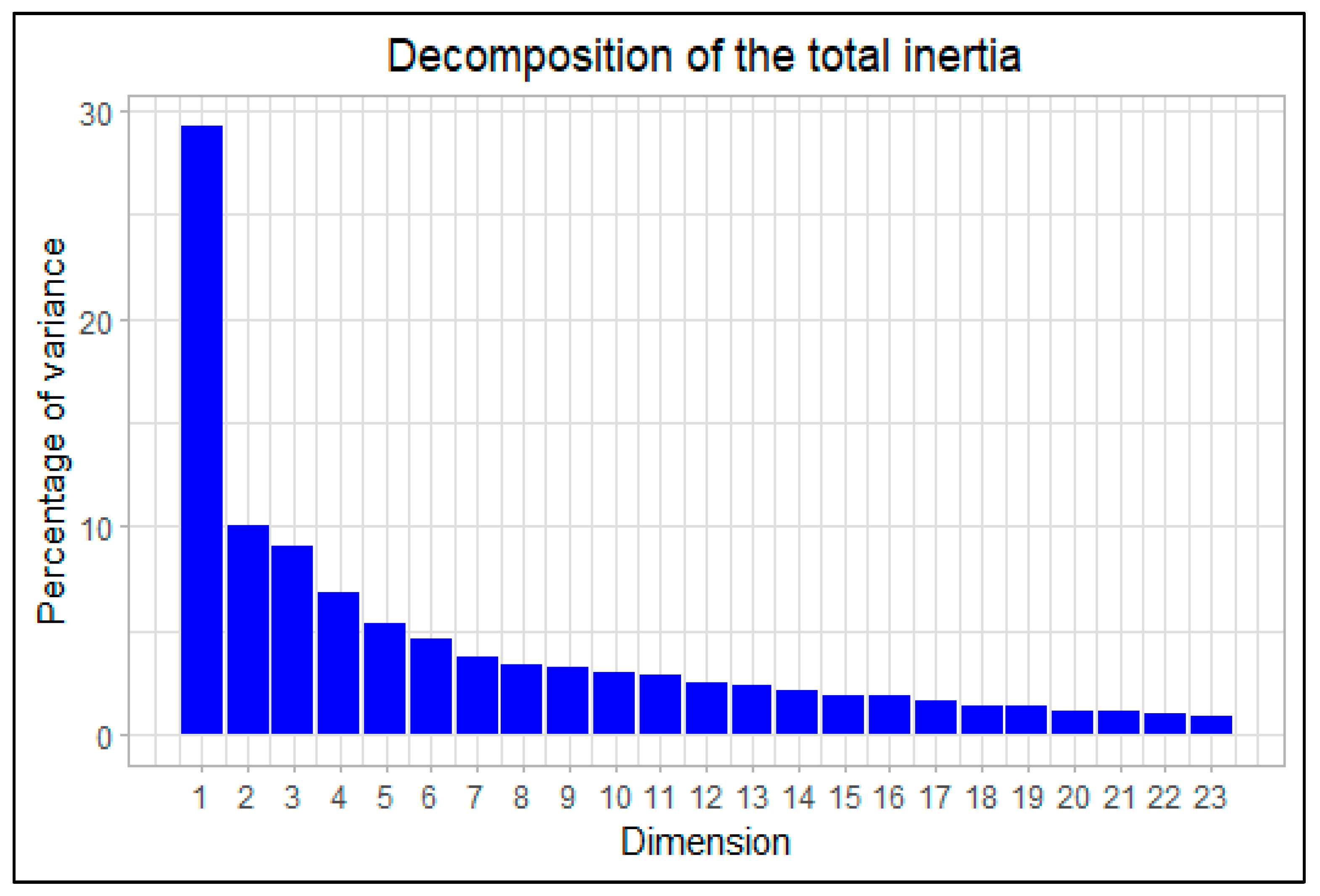
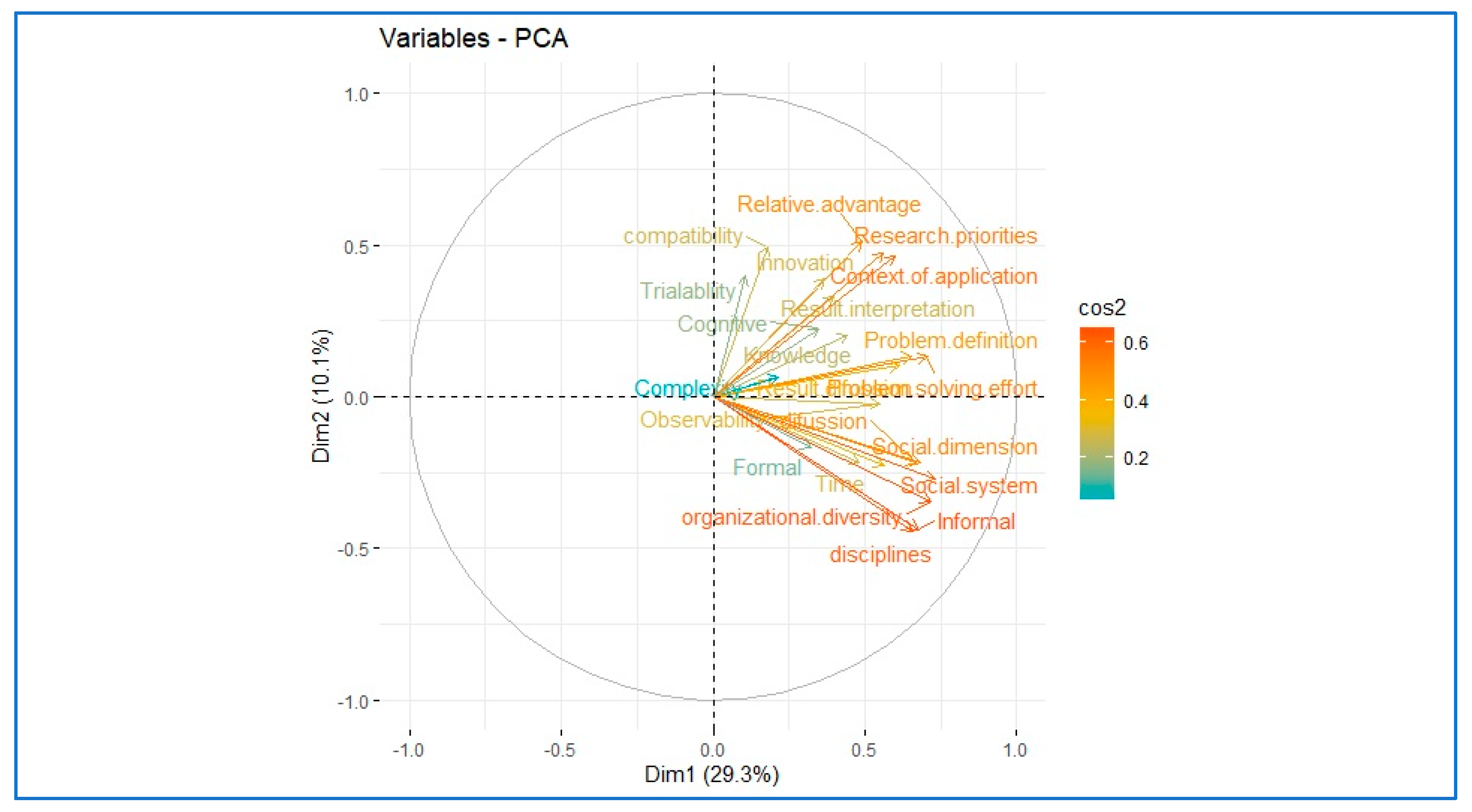
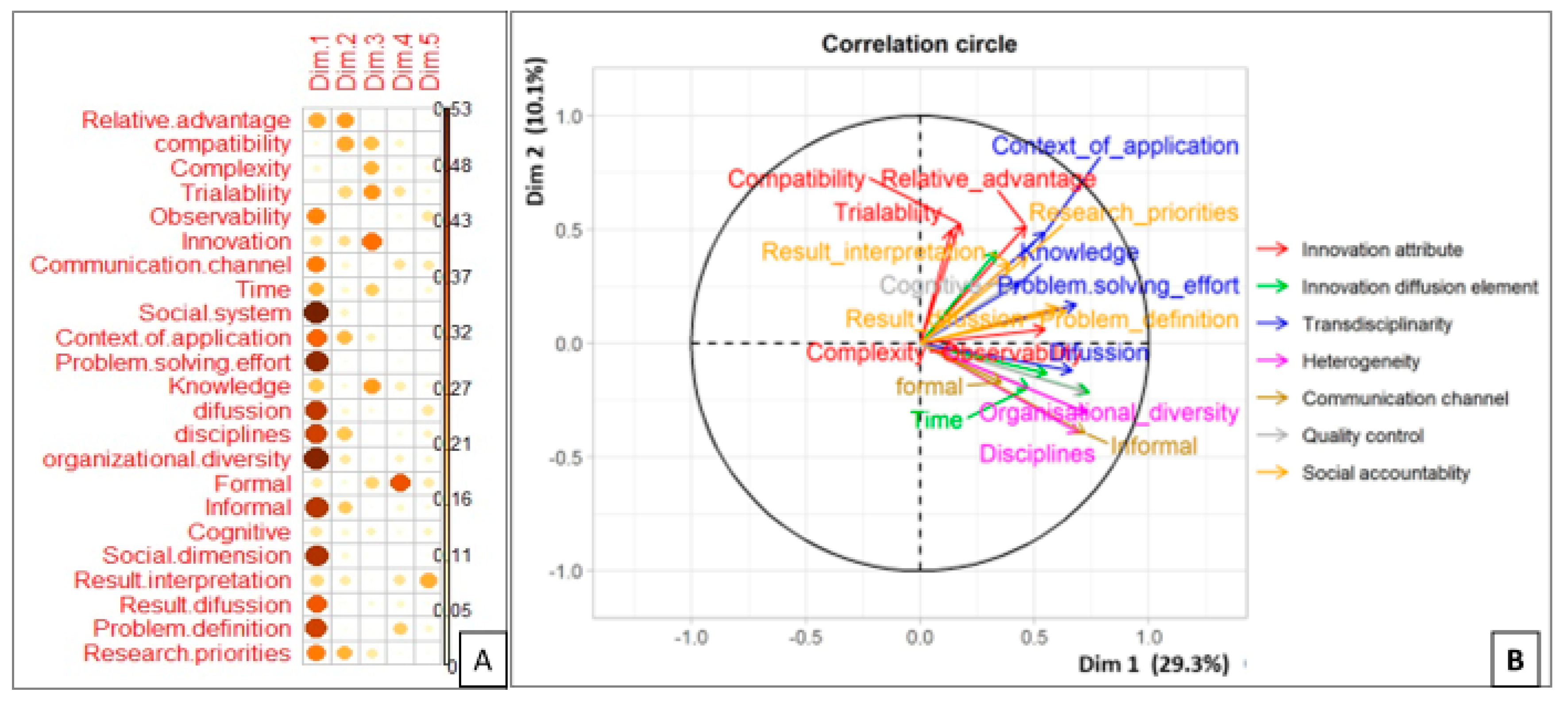

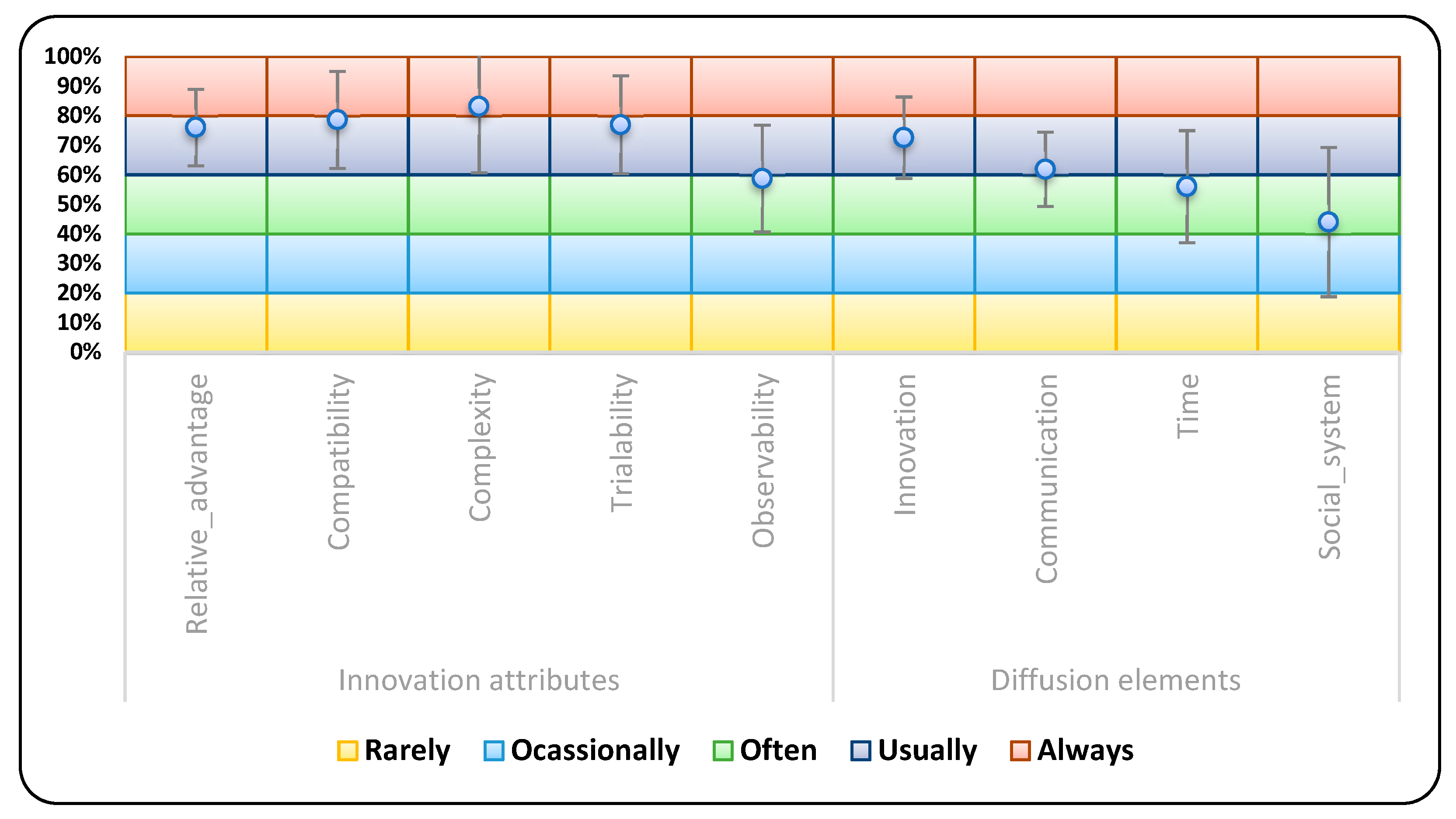
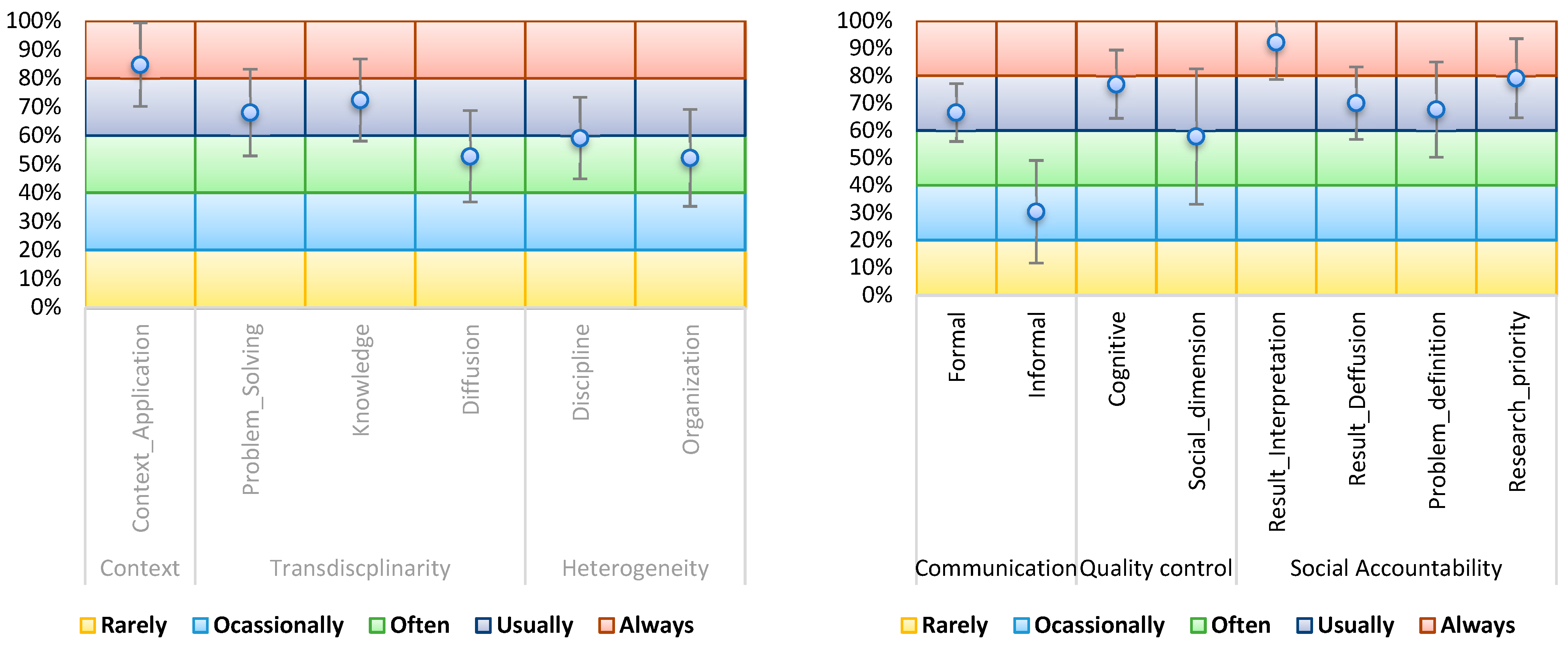
| Variables | Variable Category | 1 (Never) | 2 (Occasionally) | 3 (Often) | 4 (Usually) | 5 (Always) | Explanation |
|---|---|---|---|---|---|---|---|
| Relative advantage (RA) | Not at all | Some what | Fairly | Highly | Extremely | The degree to which an innovation is perceived as being better than the idea it supersedes | |
| Compatibility | Not at all | Some what | Fairly | Highly | Extremely | The degree to which an innovation is perceived as consistent with the existing values, past experiences, and needs of potential adopters | |
| Complexity | Not at all | Some what | Fairly | Highly | Extremely | The degree to which an innovation is perceived as relatively difficult to understand and use | |
| Trialabliity | Not at all | Some what | Fairly | Highly | Extremely | The degree to which an innovation may be experimented with on a limited basis | |
| Observability | Not at all | Some what | Fairly | Highly | Extremely | The degree to which the results/outcome of an innovation are visible to others | |
| Innovation (innovativeness) | Not at all | Some what | Fairly | Highly | Extremely | Ideas, practices, or projects that are perceived as new by an individual or other unit of adoption | |
| Communication channels | Not at all | Some what | Fairly | Highly | Extremely | Processes by which participants create and share information with one another to reach a mutual understanding | |
| Time | Not at all | Some what | Fairly | Highly | Extremely | Time required for an innovation to disseminate and adopt | |
| Social systems | Not at all | Some what | Fairly | Highly | Extremely | Sets of interrelated units engaged in joint problem-solving to accomplish a common goal | |
| Context of application | Not at all | Some what | Fairly | Highly | Extremely | ||
| Transdisciplinarity | Problem solving effort | Not at all | Some what | Fairly | Highly | Extremely | Involvement of relevant stakeholders in problem-solving effort |
| Knowledge | Not at all | Some what | Fairly | Highly | Extremely | Generation of multidisciplinary knowledge of the context | |
| Difussion | Not at all | Some what | Fairly | Highly | Extremely | Involvement of stakeholders in diffusion of innovation generated | |
| Heterogeneity | Disciplines | Not at all | Some what | Fairly | Highly | Extremely | Involvement of stakeholders from different disciplines in addition to traditional science from university departments |
| Organizational diversity | Not at all | Some what | Fairly | Highly | Extremely | Involvement of different organizations outside academic organizations | |
| Communication | formal | Not at all | Some what | Fairly | Highly | Extremely | Type and quality of academic publications in the form of peer-reviewed journal articles, dissertations, pamphlets, leaflets, etc.) |
| informal | Not at all | Some what | Fairly | Highly | Extremely | Dissemination of findings to different stakeholders in addition to formal academic publications, such as community engagements, demonstrations, exhibitions, etc. | |
| Quality control | Cognitive | Not at all | Some what | Fairly | Highly | Extremely | Academic rigor and soundness of the innovation and generation process |
| Social dimension | Not at all | Some what | Fairly | Highly | Extremely | Multi-dimensionality (socio-economic, political, cultural) | |
| Social accountability | Result interpretation | Not at all | Some what | Fairly | Highly | Extremely | The inclusion of social issues in result (environment, health, privacy, public interests) |
| Result diffusion | Not at all | Some what | Fairly | Highly | Extremely | Result dissemination and reach to wider public | |
| Problem definition | Not at all | Some what | Fairly | Highly | Extremely | Collective definition and identification through involvement of stakeholders for collective responsibility | |
| Research priorities | Not at all | Some what | Fairly | Highly | Extremely | The importance of research based on capacity and need |
| Top 10 Variables | Dim.1 | Ctr | Cos2 | Dim.2 | Ctr | Cos2 | Dim.3 | Ctr | Cos2 |
|---|---|---|---|---|---|---|---|---|---|
| Relative advantage | 0.490 | 3.561 | 0.240 | 0.512 | 11.32 | 0.262 | −0.152 | 1.099 | 0.023 |
| Compatibility | 0.178 | 0.473 | 0.032 | 0.496 | 10.601 | 0.246 | 0.457 | 10.007 | 0.209 |
| Complexity | 0.214 | 0.681 | 0.046 | 0.065 | 0.18 | 0.004 | −0.476 | 10.837 | 0.226 |
| Trialabliity | 0.106 | 0.167 | 0.011 | 0.397 | 6.814 | 0.158 | 0.525 | 13.224 | 0.276 |
| Observability | 0.552 | 4.522 | 0.304 | −0.024 | 0.026 | 0.001 | 0.100 | 0.482 | 0.010 |
| Innovation | 0.367 | 2.001 | 0.135 | 0.389 | 6.523 | 0.151 | −0.581 | 16.170 | 0.338 |
| Communication channels | 0.563 | 4.714 | 0.317 | −0.228 | 2.247 | 0.052 | −0.085 | 0.345 | 0.007 |
| Time | 0.482 | 3.449 | 0.232 | −0.218 | 2.050 | 0.047 | −0.432 | 8.949 | 0.187 |
| Social systems | 0.731 | 7.942 | 0.535 | −0.273 | 3.210 | 0.074 | 0.027 | 0.034 | 0.001 |
| Context of application | 0.600 | 5.345 | 0.360 | 0.465 | 9.345 | 0.217 | −0.298 | 4.248 | 0.089 |
| Classification | Variables | Intern Freq. | Glob Freq. | p.Value | v.Test |
|---|---|---|---|---|---|
| Cluster 1 | Compatibility | 196 | 322 | 4.084051 × 10−03 | 2.871596 |
| Trialabliity | 187 | 313 | 1.584161 × 10−02 | 2.412544 | |
| Organizational diversity | 79 | 177 | 2.885287 × 10−02 | −2.185491 | |
| Social systems | 34 | 132 | 2.252916 × 10−10 | −6.343029 | |
| Informal communication | 4 | 57 | 2.206909 × 10−13 | −7.335624 | |
| Social dimension | 6 | 98 | 1.608176 × 10−23 | −9.994673 | |
| Cluster 2 | Social.dimension | 53 | 98 | 4.779540 × 10−11 | 6.577646 |
| Social systems | 43 | 132 | 1.587664 × 10−02 | 2.411739 | |
| Informal communication | 5 | 57 | 8.481098 × 10−03 | −2.632292 | |
| Cluster 3 | Informal communication | 48 | 57 | 1.196667 × 10−21 | 9.558335 |
| Social systems | 55 | 132 | 7.028043 × 10−06 | 4.492837 | |
| Social dimension | 39 | 98 | 5.834247 × 10−04 | 3.439205 | |
| Organizational diversity | 58 | 177 | 7.749489 × 10−03 | 2.662794 | |
| Disciplines | 32 | 160 | 1.450073 × 10−02 | 2.444614 |
Publisher’s Note: MDPI stays neutral with regard to jurisdictional claims in published maps and institutional affiliations. |
© 2022 by the authors. Licensee MDPI, Basel, Switzerland. This article is an open access article distributed under the terms and conditions of the Creative Commons Attribution (CC BY) license (https://creativecommons.org/licenses/by/4.0/).
Share and Cite
Dorji, K.; Miller, J.; Wu, S. An Inquiry into Bhutanese Agriculture Research–Practice Gaps Using Rogers Innovation Adoption Attributes and Mode 2 Knowledge Production Features. Soc. Sci. 2022, 11, 536. https://doi.org/10.3390/socsci11120536
Dorji K, Miller J, Wu S. An Inquiry into Bhutanese Agriculture Research–Practice Gaps Using Rogers Innovation Adoption Attributes and Mode 2 Knowledge Production Features. Social Sciences. 2022; 11(12):536. https://doi.org/10.3390/socsci11120536
Chicago/Turabian StyleDorji, Kinley, Judith Miller, and Shubiao Wu. 2022. "An Inquiry into Bhutanese Agriculture Research–Practice Gaps Using Rogers Innovation Adoption Attributes and Mode 2 Knowledge Production Features" Social Sciences 11, no. 12: 536. https://doi.org/10.3390/socsci11120536
APA StyleDorji, K., Miller, J., & Wu, S. (2022). An Inquiry into Bhutanese Agriculture Research–Practice Gaps Using Rogers Innovation Adoption Attributes and Mode 2 Knowledge Production Features. Social Sciences, 11(12), 536. https://doi.org/10.3390/socsci11120536






